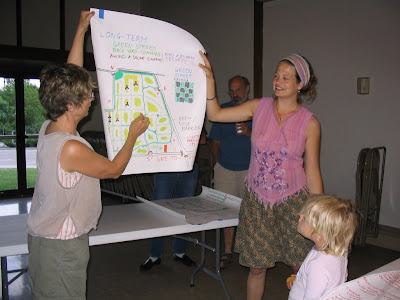GANA Speaker Series
Lucille Bertuccio
Director of Bloomington's Center for Sustainable
Living 8:00 – 9:15 p.m., May 31, 2006
(after our monthly meeting, see meeting report)
Summary
Lucille introduced us to the concept of a "Backyard Wildlife Habitat" and its benefits.
The Process
The Center for Sustainable Living has endorsed the National Wildlife Federation concept of wildlife habitats in people's yards as a part of a nationwide movement to encourage natural surroundings for birds and butterflies. At this point, the city of Bloomington itself has been registered but not certified as a wildlife habitat. So far, 140 Bloomington homes have had their yards certified, and we need 60 more for the 200 yards required for Bloomington to be officially certified. To get certified, backyards must provide food, water, shelter, and places for birds and butterflies to raise their young.
The certification process is not difficult. See www.nwf.org/backyardwildlifehabitat/
Lucille presented a number of slides to show what backyard habitats can look like, and described their benefits to birds and butterflies. Two keys:
- Work with different levels (canopy trees, understory trees, bushes and shrubs, plants, moss)—so that the critters can have a diversity of places to shelter and nourish themselves.
- Work with native plants that are adapted to this environment (including its insects). This eliminates the need for water, chemical fertilizer and pesticides.
The point is, she says, "we need to work with nature rather than against her."And "when we increase biodiversity, we heal the fabric of nature." Monocultures, for example, large green lawns with but a single tree, are wastelands to wild creatures, take up huge amounts of resources (including gas for terrifically polluting lawnmowers), and poison the earth’s soil, air and water supply. Instead, Lucille says, rather than call it a "weedy lawn," rename it "flowery mead"!
Lucille brought up a number of details that few of us know. Like the fact that certain creatures require a single plant for a certain function: for example, the zebra swallowtail butterfly eats only the paw paw leaves and the monarch butterfly larvae can only live on the swamp milkweed. So it’s good to know which native plants are necessary if you want to attract certain species of butterfly.
Most birds need cavities or holes to raise their young. So build birdhouses (which need to be species-specific), and keep those old trees with holes in them. Also, if you want birds, then don’t deadhead your plants, as birds eat their seeds.
Lucille told us of packets of seedlings sold by the Department of Natural Resources specially designed to attract certain species. (Google DNR to get more info on these inexpensive packets that neighbors of which could share the cost: 50 each of 4 species of your choice, all for $90. Nathan Harmon agreed to spearhead this idea in Green Acres.)
In conclusion, Lucille told us that as time goes on, fewer and fewer butterflies have been visiting her yard. She implored us to help her own backyard habitat by creating habitats in Green Acres so that the butterflies won’t have as far to fly from one nourishing spot to another.
Ann Kreilkamp
GANA scribe View full story>>

